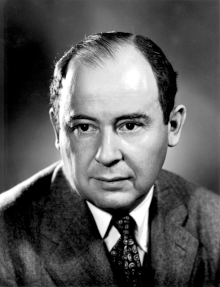///
///
| John von Neumann | |
|---|---|

Von Neumann in the 1940s
| |
| Born | Neumann János Lajos December 28, 1903 Budapest, Austria-Hungary |
| Died | February 8, 1957 (aged 53) Walter Reed General Hospital Washington, D.C. |
| Citizenship | United States |
| Nationality | Hungarian and American |
| Fields | Mathematics, physics, statistics, economics |
| Institutions | University of Berlin Princeton University Institute for Advanced Study Site Y, Los Alamos |
| Alma mater | University of Pázmány Péter ETH Zürich |
| Doctoral advisor | Lipót Fejér |
| Notable awards | Bôcher Memorial Prize (1938) Enrico Fermi Award (1956) |
| Children | Marina von Neumann Whitman |
Signature
| |
///
John von Neumann (/vɒn ˈnɔɪmən/; December 28, 1903 – February 8, 1957) was a Hungarian and later American pure and applied mathematician, physicist, inventor, polymath, and polyglot. He made major contributions to a number of fields,[3] including mathematics (foundations of mathematics, functional analysis, ergodic theory, geometry, topology, and numerical analysis), physics (quantum mechanics, hydrodynamics, and fluid dynamics), economics (game theory), computing (Von Neumann architecture, linear programming, self-replicating machines, stochastic computing), and statistics.[4] He was a pioneer of the application of operator theory to quantum mechanics, in the development of functional analysis, a principal member of the Manhattan Project and the Institute for Advanced Study in Princeton (as one of the few originally appointed), and a key figure in the development of game theory[3][5] and the concepts of cellular automata,[3] the universal constructor, and the digital computer.
Von Neumann's mathematical analysis of the structure of self-replication preceded the discovery of the structure of DNA.[6] In a short list of facts about his life he submitted to the National Academy of Sciences, he stated "The part of my work I consider most essential is that on quantum mechanics, which developed in Göttingen in 1926, and subsequently in Berlin in 1927–1929. Also, my work on various forms of operator theory, Berlin 1930 and Princeton 1935–1939; on the ergodic theorem, Princeton, 1931–1932." Along with Hungarian-born American theoretical physicist Edward Teller and Polish mathematician Stanislaw Ulam, von Neumann worked out key steps in the nuclear physics involved in thermonuclear reactions and the hydrogen bomb.
Von Neumann wrote 150 published papers in his life; 60 in pure mathematics, 20 in physics, and 60 in applied mathematics. His last work, an unfinished manuscript written while in the hospital and later published in book form as The Computer and the Brain, gives an indication of the direction of his interests at the time of his death.
///
///
Later life
In 1955, von Neumann was diagnosed with what was either bone or pancreatic cancer.[104] A von Neumann biographer, Norman Macrae, has speculated that the cancer was caused by von Neumann's presence at the Operation Crossroads nuclear tests held in 1946 at Bikini Atoll.[105]///





No comments:
Post a Comment